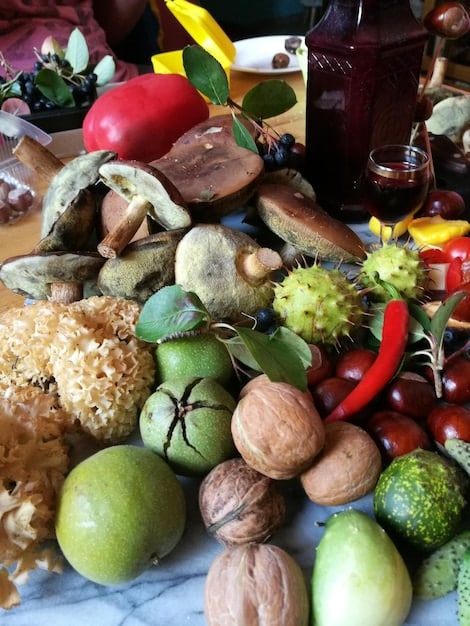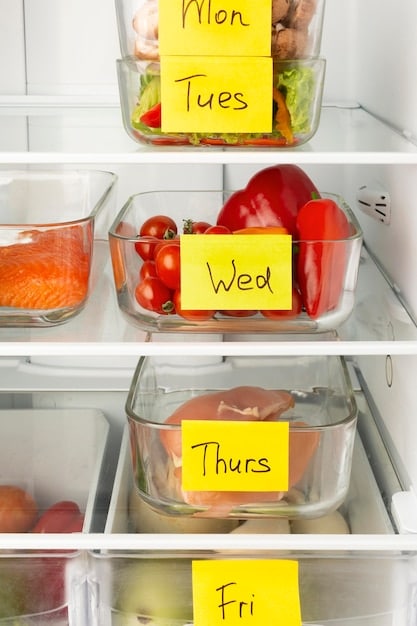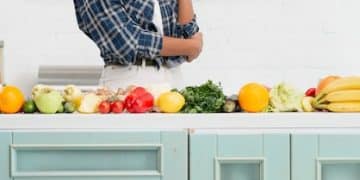DIY Food Waste Reduction: Save $75+ Monthly by Repurposing Leftovers Like a Pro

Reducing food waste at home is a practical strategy that not only benefits the environment but also leads to significant financial savings, potentially over $75 monthly, by skillfully repurposing leftover ingredients and rethinking culinary habits.
In a world increasingly focused on sustainability and smart living, mastering DIY Food Waste Reduction: Save $75+ Monthly by Repurposing Leftovers Like a Pro stands out as a powerful way to impact both your budget and the planet. This guide explores practical strategies and innovative techniques that transform kitchen scraps into culinary triumphs, demonstrating how small changes can lead to substantial monthly savings.
Understanding the Impact of Food Waste on Your Wallet and the Planet
Food waste is not merely an environmental concern; it carries a hefty financial weight for households. Each year, an astonishing amount of edible food ends up in landfills, costing families hundreds, if not thousands, of dollars. This waste represents a squandered opportunity, not just for meal preparation but for the economic well-being of every household.
Beyond the personal financial drain, the environmental ramifications are equally significant. Decomposing food in landfills produces methane, a potent greenhouse gas contributing to climate change. Reducing food waste at home is a tangible step toward mitigating these environmental impacts and fostering a more sustainable future.
The Alarming Statistics of Household Food Waste
Often, the true scale of food waste is underestimated. Studies reveal that a significant percentage of food purchased by consumers is never consumed. This includes fresh produce that spoils before it’s used, bulk purchases that exceed needs, and leftovers that are forgotten in the back of the refrigerator. Understanding where and why waste occurs is the first step toward effective reduction.
- Approximately 30-40% of the food supply in the United States goes to waste.
- For an average American family, this translates to roughly $1,500 annually in wasted food.
- A considerable portion of this waste comes from consumer habits, such as over-purchasing and poor storage.
The Economic Incentive for Food Waste Reduction
While the environmental benefits are compelling, the immediate financial incentive often resonates more directly with individuals. Saving $75 or more monthly is an achievable goal, equivalent to an extra $900 annually. This money can be redirected towards savings, debt reduction, or enjoying experiences that enhance quality of life, proving that reducing waste is truly a win-win scenario.
Consider the cumulative effect: repurposing food means you are making the most of every dollar spent at the grocery store. It shifts the mindset from disposable consumption to thoughtful utilization, aligning with broader principles of financial prudence.
Recognizing the substantial financial and environmental consequences of food waste underscores the urgency and importance of adopting strategies to minimize it. Every small action taken at home contributes to a larger positive impact.
Strategic Shopping and Smart Storage: The First Line of Defense
Minimizing food waste begins long before you even start cooking. It starts with a well-thought-out shopping list and extends to how you store your groceries once they enter your home. These foundational practices are crucial for preventing spoilage and ensuring that every item you purchase is used to its fullest potential.
Mastering the Art of the Shopping List
Impulse buys and over-purchasing are significant contributors to food waste. A detailed shopping list, based on planned meals and an inventory of existing pantry items, can drastically reduce unnecessary purchases and prevent food from expiring before it hits your plate.
Before heading to the store, take a few moments to assess what you already have. Are there ingredients nearing their expiration? Plan meals around those items first. Think about how ingredients can serve multiple purposes across different dishes. This mindful approach to shopping ensures efficiency and minimizes waste.
- Inventory before you shop: Check your fridge, pantry, and freezer to avoid buying duplicates or items you don’t need.
- Plan meals for the week: Base your shopping list on specific recipes, ensuring you buy only what’s necessary for those dishes.
- Stick to the list: Avoid tempting promotions for items not on your list, as these often lead to excess perishable food.
Optimizing Food Storage for Longevity
Proper storage is just as vital as smart shopping. Different foods require different conditions to maintain freshness and extend their shelf life. Understanding these nuances can prevent premature spoilage and reduce the likelihood of perfectly good food being thrown away.
Understanding Produce Storage
Many fruits and vegetables have specific temperature and humidity requirements. For instance, some produce like bananas, apples, and tomatoes emit ethylene gas, which can ripen other fruits and vegetables prematurely. Storing these separately is a simple yet effective way to extend the freshness of nearby items.
Leafy greens benefit from proper moisture control, often by wrapping them in a damp paper towel before placing them in a sealed bag or container. Root vegetables, on the other hand, prefer cool, dark, and dry environments. Knowing these small tricks can make a big difference.
Airtight Containers and Freezing Techniques
For cooked foods and opened packages, airtight containers are indispensable. They protect food from air exposure, which causes oxidation and spoilage. Furthermore, the freezer is a powerful tool in waste reduction, allowing you to preserve foods for much longer periods. Blanching vegetables before freezing, for example, helps retain their color, texture, and nutrients.
Strategic shopping and smart storage are not just about neatness; they are active components of a waste-reduction strategy. By implementing these practices, you lay a solid foundation for a kitchen that functions efficiently and cost-effectively, reducing the need to discard food prematurely.

Beyond the Bin: Creative Repurposing of Leftovers and Scraps
Once you’ve successfully navigated shopping and storage, the next frontier in food waste reduction is the creative repurposing of leftovers and food scraps. This is where innovation truly shines, allowing you to transform what might seem like waste into delicious and useful components for future meals. It’s about changing your perspective on what is considered “trash” in the kitchen.
Transforming Vegetable Scraps into Flavorful Broth
Vegetable scraps, such as onion skins, carrot tops, celery ends, and mushroom stems, are often discarded without a second thought. However, these humble remnants are packed with flavor and nutrients, making them perfect candidates for homemade vegetable broth. This foundational ingredient can elevate countless dishes and save you money on store-bought alternatives.
Simply collect your clean vegetable scraps in a large freezer bag over time. Once full, simmer them with water, herbs, and spices for an hour or two. Strain the solids, and you’ll have a rich, aromatic broth ready to use in soups, stews, risottos, or as a cooking liquid for grains.
- Collect scraps: Keep a designated container or bag in your freezer for vegetable odds and ends.
- Slow simmer: Extract maximum flavor by simmering scraps gently for an extended period.
- Freeze for later: Portion the finished broth into ice cube trays or containers for easy access.
Reimagining Stale Bread: From Croutons to Bread Pudding
Stale bread is a common culprit in food waste, but it’s incredibly versatile. Instead of tossing it, envision its potential for new creations. Dry bread is ideal for making homemade croutons, breadcrumbs, or even a savory bread pudding. These repurposed items can add texture and flavor to a variety of meals.
For croutons, simply cube the bread, toss with olive oil and seasonings, and bake until crispy. Breadcrumbs can be made by processing dried bread in a food processor, perfect for coating proteins or thickening sauces. Sweet versions like French toast or bread pudding are delightful ways to bring stale bread back to life.
Fruit Peels and Cores: Unexpected Culinary Gems
The peels and cores of fruits often contain a surprisingly high concentration of flavor and nutrients. Citrus peels can be candied, zested for recipes, or infused into vinegars and oils. Apple cores and peels, though often overlooked, are excellent for making apple cider vinegar, flavored waters, or even a simple compote.
Consider infusing water with cucumber peels and mint for a refreshing drink, or using watermelon rinds in pickling recipes. These small acts of repurposing not only reduce waste but also introduce new dimensions of flavor and utility into your cooking.
By shifting your mindset and seeing “waste” as an opportunity, you open up a world of creative culinary possibilities. Repurposing leftovers and scraps is a cornerstone of effective DIY food waste reduction, directly contributing to monthly savings and a more resourceful kitchen.
Fermentation and Preservation: Ancient Wisdom for Modern Savings
Before refrigeration became widespread, our ancestors relied on various methods of fermentation and preservation to extend the shelf life of food. These time-honored techniques are making a comeback, not only for their health benefits but also as powerful tools in the fight against food waste. Embracing these methods allows you to save seasonal abundance for later, reducing spoilage and enhancing flavor.
The Magic of Fermentation: Kimchi, Sauerkraut, and Beyond
Fermentation is a natural process where microorganisms, like yeast and bacteria, convert carbohydrates into alcohol or organic acids. This process not only preserves food but also often enhances its nutritional value and creates unique, complex flavors. Common fermented foods include sauerkraut, kimchi, and kombucha, but the possibilities are vast.
Cabbage, a common and inexpensive vegetable, is easily transformed into sauerkraut or kimchi, extending its usability by months. Vegetables nearing their prime, instead of being discarded, can be lacto-fermented, turning them into probiotic-rich condiments. This process actively prevents waste by giving food a second, longer life.
- Cabbage and carrots: Ideal for homemade sauerkraut or kimchi.
- Leftover vegetables: Pickle or ferment excess cucumbers, radishes, or green beans.
- Dairy: Turn excess milk into yogurt or kefir.
Canning and Freezing: Locking in Freshness
While often associated with large-scale production, canning and freezing are highly effective DIY preservation methods for home cooks. Canning, when done correctly, creates a vacuum seal that keeps foods safe and fresh for extended periods without refrigeration. Freezing halts the growth of microorganisms, preserving food quality for months.
When you have an abundance of seasonal produce—think berries in summer or tomatoes in late summer—canning them as jams, jellies, or sauces means you can enjoy their freshness year-round. Similarly, blanching and freezing vegetables like corn, peas, or green beans allows you to preserve their peak flavor and texture for future meals, preventing food from spoiling.
Dehydration and Drying: Concentrating Flavors
Dehydration involves removing moisture from food, which inhibits microbial growth and preserves the item. This method is excellent for fruits, vegetables, and even herbs. Dried fruits make healthy snacks, and dried herbs retain their potency for much longer than fresh ones.
A simple food dehydrator or even a low oven setting can transform abundant fresh produce into shelf-stable goods. Think of sun-dried tomatoes made from overripe backyard tomatoes, or crispy apple chips from a surplus of apples. These methods not only prevent waste but also create gourmet-quality ingredients from otherwise discarded items.
By incorporating these ancient preservation techniques into your modern culinary routine, you unlock a powerful strategy for food waste reduction. They empower you to manage your food supply more effectively, ensuring that seasonal bounty never goes to waste and contributing significantly to monthly savings.

Beyond the Plate: Composting and Zero-Waste Kitchen Habits
Even with the most meticulous efforts in shopping, storage, and repurposing, some food scraps will inevitably remain inedible. This is where composting becomes an invaluable part of a comprehensive food waste reduction strategy, closing the loop and returning nutrients to the earth. Embracing zero-waste kitchen habits further minimizes your environmental footprint and maximizes resource efficiency.
The Benefits of Composting Food Scraps
Composting transforms organic waste—like fruit and vegetable peels, coffee grounds, and eggshells—into a nutrient-rich soil amendment. Instead of these items ending up in a landfill, where they decompose anaerobically and produce harmful methane gas, composting allows them to break down aerobically, creating valuable humus for gardens and plants. This process reduces your household’s contribution to landfills, lessens the demand for chemical fertilizers, and improves soil health.
Starting a compost bin, whether it’s a simple backyard pile or a countertop vermicomposting system, is a relatively easy step. It’s a tangible way to see your waste diminish and to actively participate in regenerating natural resources. The resulting compost can be used to enrich your own garden, potted plants, or even donated to community gardens.
- Reduces landfill waste: Diverts organic materials from municipal waste streams.
- Creates rich soil: Produces a natural, nutrient-filled fertilizer for plants.
- Mitigates climate change: Prevents methane emissions from anaerobic decomposition in landfills.
Implementing Zero-Waste Kitchen Habits
Adopting zero-waste principles in the kitchen goes beyond just managing food. It encompasses a broader approach to consumption, aiming to minimize all forms of waste, from packaging to single-use items. This holistic perspective can lead to significant environmental and financial benefits.
Bulk Buying and Reusable Containers
One of the easiest ways to reduce packaging waste is to purchase dry goods like grains, pasta, nuts, and spices in bulk using reusable bags or containers. Many grocery stores offer bulk sections, allowing you to buy only the amount you need and avoid excessive packaging. This often saves money per pound as well.
Ditching Single-Use Items
Replace single-use plastic wrap and aluminum foil with reusable alternatives like beeswax wraps, silicone lids, and glass containers. Instead of paper towels, opt for reusable cloth rags or sponges. These small shifts reduce waste and, over time, save money on disposable items.
Mindful Consumption and Repair
A zero-waste mindset also encourages mindful consumption—buying only what is needed and choosing durable, long-lasting products. It also embraces repair over replacement, extending the life of kitchen tools and appliances when possible. This approach fosters a more sustainable relationship with resources.
Composting and adopting zero-waste habits are crucial final steps in the journey of food waste reduction. They ensure that even the inedible parts of your food contribute positively to the environment, while broader kitchen practices minimize overall waste and maximize resource efficiency, creating a truly sustainable and cost-effective home.
Meal Planning and Portion Control: Preventing Waste Before It Starts
Effective meal planning and judicious portion control are proactive strategies that tackle food waste at its very root. By thinking ahead about what you’ll eat and how much, you significantly reduce the chances of purchasing excess food or generating untouched leftovers. These practices work in tandem to optimize your food budget and minimize discarded meals.
The Blueprint of Efficient Meal Planning
Meal planning involves more than just deciding what to cook; it’s about strategizing your week’s meals to utilize ingredients efficiently and minimize waste. This means considering how ingredients can be cross-utilized in different dishes, incorporating existing leftovers, and aligning your shopping list precisely with your culinary intentions.
Start by assessing your current food inventory. What needs to be used up first? Then, build your weekly meal plan around these items, ensuring variety and nutritional balance. A successful meal plan anticipates future needs and prevents reactive cooking, which often leads to unused ingredients.
- Ingredient Cross-Utilization: Plan meals that use similar ingredients (e.g., bell peppers for stir-fry one night, then fajitas the next).
- “Use It Up” Meals: Designate a night each week for a “leftover makeover” or a “clean out the fridge” meal, using up odds and ends.
- Flexibility is Key: While planning is important, remain flexible enough to adapt to unexpected changes or opportunities to use surplus ingredients.
Mastering Portion Control for Minimal Leftovers
Serving appropriate portion sizes is critical for reducing plate waste. Often, people serve more food than they can comfortably eat, leading to uneaten portions that are difficult or impossible to save. Understanding personal consumption habits and adjusting serving sizes accordingly can make a significant difference.
Begin by serving smaller portions, allowing for second helpings if genuinely needed. For meals cooked in larger batches, immediately portion out leftovers into individual containers for easy storage and future grab-and-go meals. This not only prevents overeating but also ensures that any extra food is properly stored and consumed.
Right-Sizing Your Cooking
Adjusting recipe yields to match your household’s size is another form of portion control. If you’re cooking for one or two, scale down recipes designed for a family of four. If you deliberately cook large batches for meal prepping, ensure you have a clear plan for freezing or consuming those portions within a safe timeframe.
Efficient meal planning and mindful portion control are preventative measures that significantly impact food waste. They encourage a more intentional approach to eating and cooking, ensuring that what you buy and prepare is consumed, ultimately saving money and reducing your environmental footprint.
The Financial Rewards: Quantifying Your Monthly Savings
While the environmental benefits of reducing food waste are impactful, the tangible financial savings often serve as the most immediate and motivating factor for individuals. By consistently applying the strategies discussed—from smart shopping to creative repurposing and vigilant meal planning—you can realistically expect to see a significant boost to your bank account, potentially exceeding $75 each month.
Breaking Down the Potential Savings
To understand how these savings accumulate, consider various areas where waste reduction directly translates into cash saved:
Reduced Grocery Bills: By planning meals meticulously and only buying what you need, you avoid impulse purchases and overstocked refrigerators that lead to spoilage. If an average household wastes food worth $125 per month, even a 60% reduction could save you $75 in groceries alone.
Fewer Takeout Meals: When you effectively use your ingredients and have readily available repurposed meals or intentional leftovers, the temptation to order takeout decreases. A single takeout meal for a family can easily be $30-$50. Reducing this by just two occurrences a month adds $60-$100 to your savings.
Extended Shelf Life, Less Replenishment: Proper storage and preservation techniques mean your food lasts longer. This reduces the frequency of needing to replace items that went bad prematurely, directly prolonging the utility of your initial purchase.
Value-Added From Scraps: Using vegetable scraps for broth (saving $3-$5 per carton), making your own breadcrumbs ($2-$3 per loaf of stale bread), or creating fruit-infused water ($1-$2 for a bottled flavored drink) are small savings that compound over time, potentially adding $10-$20 monthly.
Lower Waste Disposal Costs (Indirect): While not directly hitting your wallet monthly, reduced volume of trash could lead to future savings in municipal waste fees in some areas, or at least alleviate the environmental cost. The most direct saving is simply not having to buy food you then throw away.
Beyond the Dollar Amount: The Value of Reskilling
The financial aspect, while compelling, is only part of the story. The process of reducing food waste inherently builds valuable skills: you become a more astute shopper, a more creative cook, and a better manager of household resources. This reskilling has benefits that extend beyond the kitchen, fostering a more resourceful and financially resilient mindset in other areas of your life.
The initial investment is primarily time and a shift in mindset. However, the returns are substantial, not just financially but also in terms of environmental impact and newfound culinary confidence. Tracking your progress, even informally, can further motivate you as you witness the tangible results of your efforts. Saving over $75 monthly by adopting DIY food waste reduction is not just a pipe dream; it’s a realistic, achievable goal for any household committed to smart living.
Overcoming Common Obstacles and Staying Motivated
Embarking on a journey to significantly reduce food waste, while rewarding, isn’t always without its challenges. Life happens: busy schedules, unexpected events, and occasional forgetfulness can derail even the best intentions. Recognizing these common hurdles and developing strategies to overcome them is key to long-term success and sustained motivation.
Addressing Time Constraints and Busy Schedules
One of the most frequently cited reasons for food waste is a lack of time. “I didn’t have time to cook it,” or “I forgot about it until it was too late,” are common refrains. The antidote lies in proactive planning and finding efficient hacks that fit into a busy lifestyle.
Batch cooking and meal prepping: Dedicate a few hours on a less busy day to prepare components of meals (chopping vegetables, cooking grains, preparing sauces) or entire dishes that can be easily reheated or assembled later in the week. This ensures healthy, homemade options are always within reach, reducing reliance on spontaneous, often wasteful, food decisions.
Simple recipes: Embrace recipes that are quick to prepare and use minimal ingredients. Not every meal needs to be gourmet. Sometimes, a simple pasta dish with leftover roasted vegetables or a quick omelet with expiring cheese is perfect.
Battling the “Out of Sight, Out of Mind” Phenomenon
It’s easy for food to get lost in the back of the fridge or pantry, leading to forgotten items and eventual spoilage. Implementing clear organization and visual reminders can combat this common issue.
“Eat me first” zone: Designate a specific shelf or bin in your refrigerator for items that need to be consumed soon. This acts as a visual cue during meal prep. Similarly, organize your pantry so older items are moved to the front.
Regular inventory checks: Make it a habit to quickly scan your fridge and pantry before grocery shopping and at least once mid-week. This helps you identify items nearing expiration and inspires meals that use those ingredients.
Staying Motivated and Celebrating Small Wins
Change can be challenging, and maintaining new habits requires continuous motivation. Focus on the positive impacts and celebrate your progress, no matter how small.
Track your savings: Keep a running tally of the money you believe you’ve saved by reducing food waste. Seeing the numbers increase can be incredibly motivating.
Experiment and share: Turn food waste reduction into a creative outlet. Experiment with new recipes for scraps, and share your successful creations with friends and family. Their positive feedback can provide encouragement.
Educate your household: Involve everyone living in your home in the effort. When everyone understands the benefits and plays a role, it becomes a collective success. Small, consistent efforts, combined with an understanding of potential pitfalls, ensure that your commitment to food waste reduction remains strong and effective over the long term.
| Key Strategy | Brief Benefit |
|---|---|
| 🛒 Smart Shopping | Avoids impulse buys and over-purchasing, reducing initial waste. |
| 🧊 Optimal Storage | Extends food freshness, preventing premature spoilage. |
| 👩🍳 Creative Repurposing | Transforms scraps into new dishes, maximizing every ingredient’s value. |
| 🗓️ Meal Planning | Ensures all purchased food is consumed and reduces last-minute waste. |
Frequently Asked Questions about DIY Food Waste Reduction
▼
While savings vary per household, the average American family wastes about $1,500 annually on food. Implementing effective waste reduction strategies like smart shopping, proper storage, and repurposing can realistically save you over $75 monthly, translating into significant annual savings.
▼
Begin with clear meal planning and a disciplined shopping list based on your needs. Next, focus on proper food storage, familiarizing yourself with how different foods prefer to be kept. Finally, make an effort to use older ingredients first and creatively repurpose common scraps like vegetable ends for broth.
▼
Absolutely. When food waste ends up in landfills, it decomposes and produces methane, a potent greenhouse gas that contributes to climate change. Reducing food waste at home lessens your environmental footprint and promotes a more sustainable food system, making a direct positive impact.
▼
For cooked leftovers, ensure they cool down quickly (within two hours) before storing them in airtight containers in the refrigerator. Consume them within 3-4 days or freeze them for longer preservation. Labeling with dates helps keep track and prevents forgotten food from going bad.
▼
Yes, several! Stale bread can become croutons or breadcrumbs. Vegetable scraps are perfect for homemade broths. Citrus peels can be zested or used to make infused vinegar. Overripe fruits are excellent for smoothies, jams, or baked goods, ensuring nothing goes to waste.
Conclusion
Embracing the principles of DIY food waste reduction is more than just a passing trend; it is a fundamental shift toward a more sustainable and economically prudent lifestyle. By integrating smart shopping, optimal storage, creative repurposing, and diligent meal planning into your daily routine, you unlock a powerful mechanism for significant monthly savings, easily exceeding $75. Beyond the financial gains, this proactive approach meaningfully contributes to environmental preservation, reducing landfill waste and minimizing your overall ecological footprint. The journey to a zero-waste kitchen is both rewarding and empowering, transforming challenging scraps into culinary possibilities and reinforcing a mindful connection with the resources we consume.





